Pentagon Rescue? Open Bloody Questions Part 3:
The Seven-Minute Fire
Part 3 of a four-part article
by Carol A. Valentine
President, Public Action, Inc.
http://holocausts.org/
Copyright © 2002
May be reproduced for non-commercial purposes
"There cannot be any survivors; it just would be beyond comprehension." —Donald Rumsfeld, US Secretary of Defense, speaking of missing Pentagon personnel on September 11, 2001, just nine hours after impact. (Rumsfeld 2001)
An Essay in Four Parts
- Part 1: Were They Rescued from the Fire?
- Part 2: Were They Rescued from the Collapsing Building?
- Part 3: The Seven-Minute Fire
- Part 4: Treason in High Places
February 7, 3023 — On June 23, 2002, I published the first two
chapters of "Pentagon Rescue? Open Blood Questions," concerning events of September 11, 2001.
In that piece, I suggested that the fire and structural collapse at the Pentagon, together with an
incompetent rescuing effort, were a lethal purge of some military intelligence personnel
(Valentine 2002a, updated and edited).
The article shows that the Pentagon chain of command conducted a sham "rescue" at the Pentagon on 9-11. Why would they do that? Well, there is good reason to suspect the fire and structural collapse at the Pentagon were, in part, covers for the murder (purge) of some military intelligence personnel. The disingenuous rescue attempt was slicked over the top to disguise the truth and to provide a plausible explanation of the victims' deaths.
"Look! Look! We're trying, but the fire just won't go out!"
"Look! Look! We're trying, but the building is too unstable!"
That last is a direct quote from Donald Rumsfeld, September 11, 2001.
Relying on official photos, news articles, and press conference transcripts, this article so far has concluded that:
- Aviation firefighters from nearby bases should have been called to extinguish the fire from the (alleged) crash of Flight 77, but civilian residential firefighters were used instead;
- Aviation firefighters use foam, not water, to extinguish aviation fuel fires, but firefighters at the Pentagon used water, not foam, on the fire;
- The fire burned for at least 60 hours — it was still burning late Thursday, September 13. (Kelley 2001)
On June 27, 2002, I posted those two chapters to four Internet Usenet groups: soc.veterans, rec.aviation.military, alt.politics.bush, alt.disasters.aviation (Valentine 2002b).
About a week later, I learned from a response (Sandy 2002) that the National Fire Prevention Association (NFPA) published an article entitled "ARFF [Aircraft Rescue Fire Fighting] Crews Respond to the Front Line at Pentagon." The dateline for the article is November 1, 2001. Here is the opening paragraph:
When a hijacked Boeing 757, skimming the street lights, smashed into the Pentagon on September 11, firefighters at nearby Reagan National Airport were the right responders in the right place with the right equipment. (Murphy 2001)
Then the next two paragraphs challenged everything the media led us to believe about the long-lasting fire at the Pentagon:
Being among the first responding fire units, National's aircraft rescue firefighters (ARFF) crews were able to set up their apparatus directly in front of the gaping hole in the Pentagon. That was where their training in fighting aircraft fires and the capability of their foam units to extinguish jet fuel fires were put to the best use.
The ARFF foam units knocked down the bulk of the fire in the first seven minutes after their arrival … (Murphy 2001)
Seven minutes?? If that was so, what did we all watch on TV? The article includes eleven contemporaneous pictures documenting the event, from the first sighting of the smoke column to scenes on September 12. Unfortunately, though the thumbnails on the main page are visible (Murphy 2001), most of the full-size photos are not available.
Surprise Arrival of Reagan National ARFF Team


According to the NFPA article, shortly before Flight 77 hit the Pentagon, a Reagan National aircraft rescue and fire-fighting team was already on the road attending a car accident on the upper level of Airport Terminal B. (Aircraft rescue firefighters don't usually respond to car accidents, of course, and there is no mention that the cars involved were on fire.) The Reagan National team had their backs to the Pentagon. At 9:38 a.m. they heard a dull roar, turned around, and saw the smoke. The article does not mention how the Reagan National team knew the Pentagon fire was the result of a plane crash; however, they left the airport immediately for the Pentagon, which was three miles away. They arrived in two or three minutes and put the bulk of the fire out in seven minutes.
Let's do the math. The Reagan National team must have arrived at the Pentagon at approximately 9:40 or 9:41 a.m. If they extinguished the bulk of the fire in seven minutes, the "bulk of the fire" was extinguished at approximately 9:47 a.m. or 9:48 a.m.
What serendipity! An aircraft rescue fire fighting team, already on the road attending a car accident they normally wouldn't attend, hears a noise, sees smoke, concludes the fire was caused by an aircraft, and arrives at the Pentagon in three minutes. Using foam, they put out the fire in seven minutes!
This was a fantastic news story. The members of the Reagan National ARFF team were national
heroes. We would expect their story to command immediate national media attention.
No Contemporaneous Coverage
With the nation grief-stricken and reeling over the loss of hundreds of New York firemen, the story of Reagan National ARFF's heroism and effectiveness would have rallied our spirits. Their story should have gotten top coverage.
But curiously, their on-the-spot heroism and competence got no mass media attention whatsoever. The local Washington, D.C. TV stations, the national TV networks, The Washington Post, The Washington Times, The New York Times, Associated Press, Reuters, Time, Newsweek, US News & World Report, The National Inquirer, etc., all missed the story.
The DoD didn't publish photographs of the Reagan National fire trucks, and DoD journalists did not tell the story; in fact, the official photographs and captions showed water being sprayed on the fire. Secretary of Defense Rumsfeld, the Chairman of the Joint Chiefs of Staff Gen. Hugh Shelton, Army Secretary White, and Arlington County Fire Chief Plaugher (who directed the firefighting effort) — none of them mentioned the amazing Reagan National story to news-hungry reporters during their press conferences.
NFPA Coverage Was "Online Exclusive"
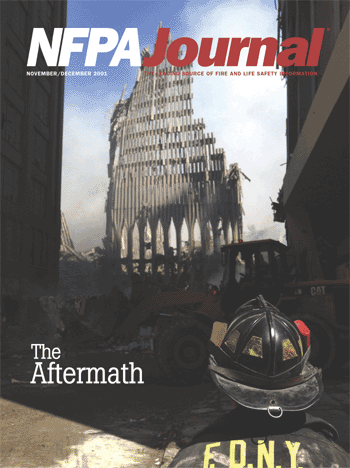
The heading over "ARFF Crews Respond to the Front Line at Pentagon" reads:
November 1, 2001
The history of that article is itself a story. The bimonthly NFPA Journal did not carry the online article in the November/December print edition (NFPA 2001).
References to the online article: Though that online article was published less than 60 days after the event—while the major media presses and the airwaves were still ablaze with 9/11 events—no other publications mentioned the online NFPA article, linked to it, or used its information. (That fact was established on August 4, 2002, using a Google tool that returned all pages linking to a target page (Google 2002.) Google's "link" tool has since been removed from the Google toolbox.)
Links to the online article: The contents page of the January/February 2002 edition of the NFPA Journal held the last link to the article (NFPA 2002a), and after that, the Journal website omitted mention of it. The NFPA Journal Archive page in June 2002 does not list it (NFPA 2002b). On August 12, 2002, the NPFA archive of authors for 1991-2001 did not list the writer, Stephen Murphy (NFPA 2002c), though a note at the bottom of the article states that Murphy was "executive editor of the Journal and managing editor of ARFF News."
Vanishing mention of the article: The 1991-2001 history of Journal subjects had no listing for the title, "ARFF Crews Respond to the Front Line at Pentagon," nor for the categories "Aircraft Crashes," "Aircraft Fires," or "Aircraft Rescue Fire Fighting (ARFF)" (NFPA 2003a). The entire index contains no mention of the Pentagon.
Online article taken offline: The article itself was removed from the NFPA website sometime between February (NFPA 2004) and April of 2004. A 2012 listing of the Journal Online Exclusives contains no articles prior to 2006 (NFPA 2012). And an outsourced archiving service has no Journal issues prior to 2012 (NxtBook 2023).
Why would the extraordinary article, "ARFF Crews Respond to the Front Line at
Pentagon," be effectively scrubbed from history? The November/December 2001 edition ran
stories about the New York attack and the heroic New York firemen who primarily performed
rescues. Compare that with the Pentagon attack and the heroic Reagan National firemen who were
there to fight the fire and fought it with great success. Surely the Pentagon article was as
appropriate to The NFPA Journal as the New York stories.
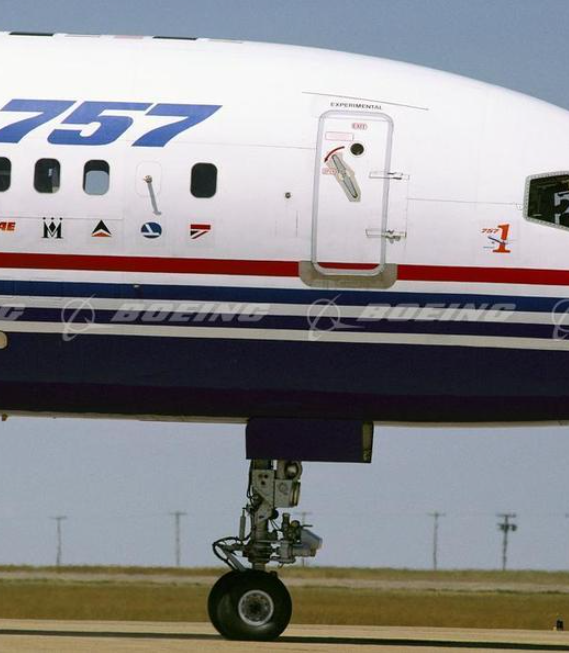
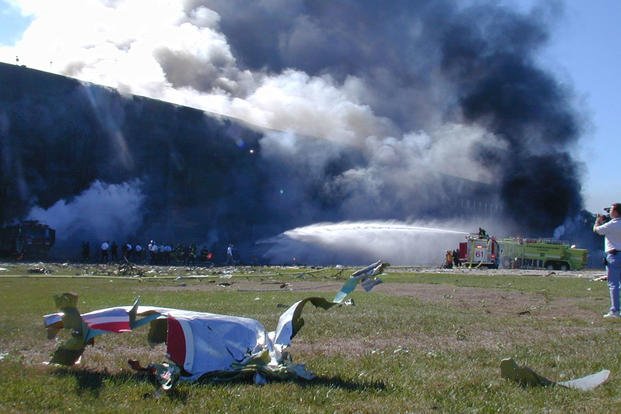
But a survey of the mainstream news media shows that, despite their key role in suppressing the fire, the Reagan National team was rarely mentioned and never thanked.
Maybe the article was unloved by the administration because it revealed that the fire that burned for days was initially "knocked down" in seven minutes.
Or maybe it was unloved because it contained unarguable eyewitness testimony of the lack of aircraft debris in the Pentagon.
That afternoon, Captain Defina and Airport Battalion Chief Walter Hood, as well as other jurisdictions' battalion chiefs, led crews inside with attack lines to fight fires on every floor of the "D" and "E" rings. The aircraft had penetrated all the way to the "C" ring.
"The only way you could tell that an aircraft was inside was that we saw pieces of the nose gear. The devastation was horrific …" Captain Defina said.
As it was outside on the lawn, so it was on the inside: No visible luggage, seats, control surfaces, engines, hydraulics … or anything else but "pieces of the nose gear." And since the nose gear would have been among the first parts to strike the exterior masonry wall, one would not expect them to be recognizable as such.
Indeed, only a small piece of debris was photographed on the lawn outside the Pentagon, hundreds of feet from the point of "impact." But American Airlines Flight 77 was a Boeing 757, and the Pentagon was a reinforced concrete building. One would expect the wings, luggage, seats, etc. from that 757 to be splayed outside the wall of the Pentagon.
April Gallop was working in her ground floor office near the "crash" site on September 11. (Gallup Interview) She reported struggling through office debris to the lawn outside — without seeing any plane parts, seats, or luggage, and without smelling or seeing jet fuel. Describing the incident, she said, "It sounded like a bomb."
Seven-Minute Fire Burns For Days
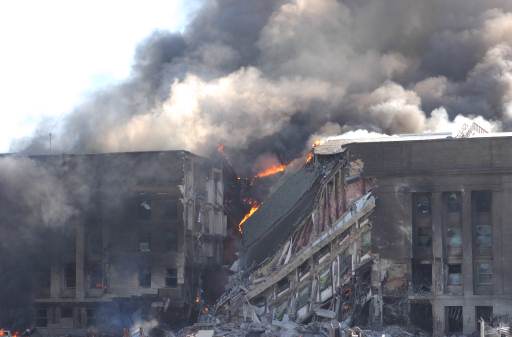
Look at this statement again:
According to CNN, the section of the roof collapsed at 10:10 a.m., roughly agreeing with NFPA's account. Recall that the structural damage to the building — caused by the alleged plane crash — had already occurred at 9:38 a.m. If the Reagan National firefighters knocked the bulk of the fire out by 9:47 a.m., what caused the roof to collapse 23 minutes later? (CNN 2001)
Despite the anomalies, the statement that the Reagan National ARFF people put the fire out with foam
in seven minutes shows how long professionals would expect such a job would take. So why did
the fire burn for days and require the attendance of "hundreds of firefighters"?
(Garamone 2001)
Problems With Truck 345
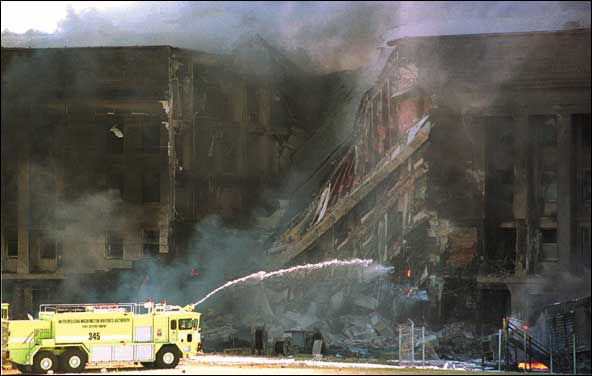
The NFPA Journal article states:
But in the photo published by the Military District of Washington, Foam Unit 345 is clearly spraying water, not foam, into the fire. And the official caption confirms. Note that a light dusting of what could be the remains of foam appears on the grass.
Arlington County Fire Chief Talks About Foam
Now let's turn our attention to a September 12, 2001, Pentagon news briefing. A reporter asked Arlington County Fire Chief Ed Plaugher, who was the fire chief in charge at the Pentagon on 9-11:
Q: Question, but with a very brief prelude. Yesterday, earlier, of course, most of the smoke and the fire seemed to be fuel from the plane, and then late yesterday afternoon, that had dissipated or been put out, and there was light smoke, and actually very little, late in the afternoon. Now there's a lot more. So, there are two questions, or a two-part question: One, what is burning? And two, what's caused the fire to start up again?
Plaugher: We were never able to fully extinguish the fire in the roof structure. We were able to get it mostly knocked down, and again because we're having extreme difficulty making access under the slate roof, it's to be expected to take awhile to get there. We have had the fuel from the jet catch fire again, and we're now in there with some additional hand-lines and some foam-lines, with aircraft firefighters inside of the insides of the Pentagon trying to suppress it, this time with fire-fighting foam.
Q: You said aircraft firefighters?
Plaugher: Yes, from the airport.
Q: From the airport?
Plaugher: From Reagan National Airport.
From the above exchange, notice:
Plaugher did not say: "A team from Reagan National came out here with foam and put the bulk of the fire out by 9:47 a.m." What a natural opportunity for Plaugher to mention the lightning-fast response of the Reagan National foam team, and their wonderful performance on September 11: Arriving two or three minutes after the event and knocking down the "bulk" of the fire in seven minutes. But he didn't.
Where Were the Cranes with Claws?


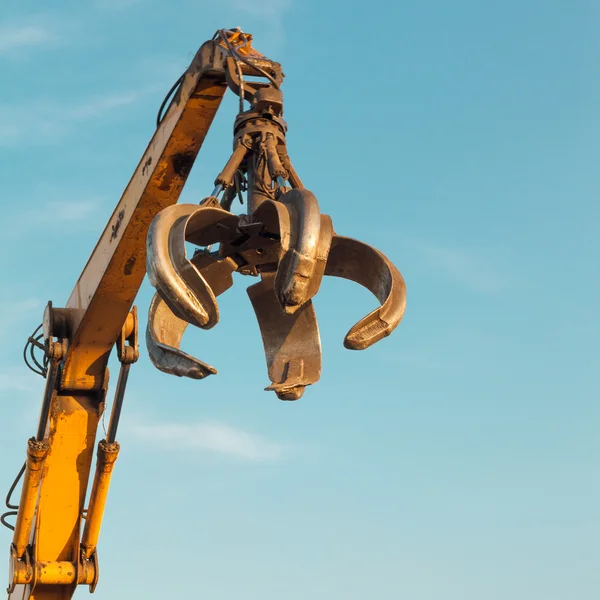

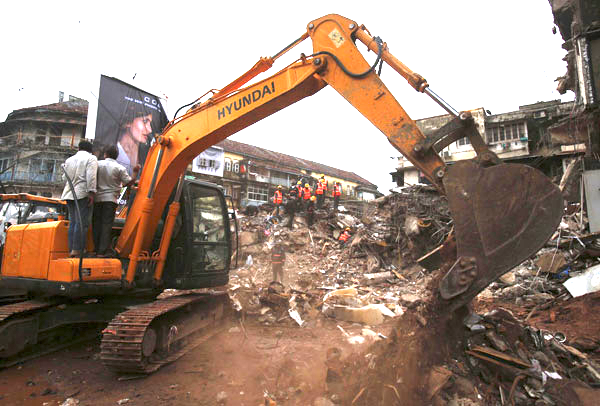
Several times throughout the press conference, Plaugher made mention of the "stubborn" roof or attic fire. The impression is given throughout this press conference and other contemporaneous media coverage that the persistent fire, together with unstable sections of the damaged building, was preventing the rescue of victims.
The Washington, D.C. area is awash with construction companies and cranes. As soon as the professional fire and rescue people saw any danger of the roof collapsing, cranes should have been ordered. Certainly, at 10:10 a.m., when the roof did collapse, cranes should have been ordered to reach those almost certainly buried by the debris.
Cranes were on the scene the next day, September 12. This NPR photo shows two cranes, right next to the collapsed roof. There is no sign of fire and no sign that the cranes were being used to lift the debris to rescue the victims trapped beneath. (Downing 2001)
Look at this photo, taken on September 13, showing different cranes right next to the collapsed roof. Again, there is no sign of fire and no sign that the cranes were being used to lift the debris to rescue the victims trapped beneath. Between the two photos, taken 24 hours apart, note that there was no progress in removing the debris to rescue the victims. (Rudisill 2001)
FBI Handcuffed Reporters Who Got Close To Fire
The FBI was edgy about anyone getting close enough to the fire to have a good look; so edgy that they handcuffed and dragged away reporters who got too close. Look at this exchange between a reporter and Pentagon flak ("Assistant Secretary of Defense for Public Affairs") Victoria Clarke:
Q: Around that side of the building where the fire is and where the fire fighting's going on, I would appreciate it if you could intercede on behalf of the FBI to make sure reporters are allowed into a certain area there and allowed access in there so — and not being threatened or, in fact, handcuffed and dragged away, that reporters do have an area close to the action where they won't necessarily interfere with things. But I — would you —
Clarke: Absolutely. You know, as I tried to say at the beginning of this, we understand and appreciate what you're trying to do. Understand and appreciate just how difficult this all is.
You know, Pam, as you said, this has never happened before. People are dealing with it remarkably, and we are going to make every effort we can to provide that kind of support, that kind of news and information to you, as we can. So we will work on that.
Contrary to Clarke's assertion, disasters with mass casualties have happened hundreds of times "before." The best practice for each contingency is carefully codified so that no one need be dealing with the problems as though they "never happened before." Clark Staten addressed the issue of intense press coverage in item #10 of his widely renowned essay on Building Collapse Rescue:
Staten urged total transparency with hourly briefings to the press. To Staten, keeping the public fully informed of the details was an essential part of disaster management.
Not so with those in charge of the Pentagon rescue. Nosy reporters were a criminal nuisance to be hustled off the scene in handcuffs. Those who have nothing to hide, hide nothing. But those who prefer to work in the shadows …
Returning to Clarke's disingenuous press conference:
Q: The only reason I say that is the FBI was just — granted they have a job to do, but they were a bit overzealous yesterday I think, and — and just —
Clarke: Let me push back on you a little bit. The FBI is doing a phenomenal job. And they have an extraordinary task on their hands, both here and elsewhere. And we, I think, surprised them a little bit, saying hey, here we come, and we didn't give them much advance notice. But going forward — and, you know, as you get into day two of this, we can start to put a lot more of those processes in place. So, heard and understood.
Reagan National ARFF Team
May Have Gatecrashed the Party
What are we to conclude? The professional aviation firefighters from Reagan National have committed themselves: Using foam, a small team could extinguish the "bulk" of a fire resulting from a Boeing 757 crashing into a building such as the Pentagon in seven minutes.
How many office buildings burn for 60 hours, despite the efforts of "hundreds of firefighters" (Garamone 2001)? Remember that the Pentagon is a reinforced masonry building …
It is quite evident that the FBI stage-managed the "persistent fire," and that it handcuffed and roughed up reporters who came too close. It would seem that the persistent fire was used as a pretext for delaying the "rescue" of the victims.
Pentagon Plane Crash Disaster Predicted:
County Fire Department To Extinguish Fire
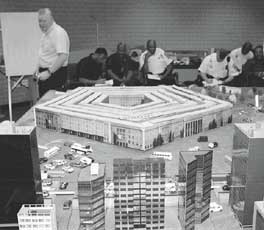
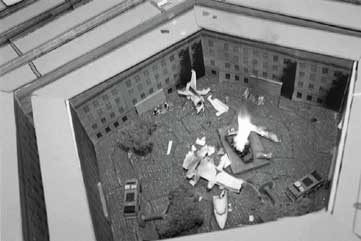
At the Military District of Washington, we learn that in October 2000, there was a practice exercise for Pentagon emergencies; scenarios in the practice session included a terrorist attack and a plane crash. See the November 3, 2002 article, "Contingency planning Pentagon MASCAL [mass casualty] exercise simulates scenarios in preparing for emergencies." (Ryan 2000a)
The article opens with these words:
Note that in the accompanying photos, the plane crash takes place inside the Pentagon courtyard.
According to the article, one of the participants thought the exercise was an excellent preparation for any potential disasters.
Note also that the Arlington County Fire Department is called in to extinguish the fire. (Ryan 2000b)
That surely was a fundamentally flawed emergency response exercise. The Arlington County Fire Department was a neighborhood fire crew, unsuited, untrained, and ill-equipped to handle a fire from a plane crash. And that article makes no mention of requesting foam trucks and ARFF teams from the metropolitan airports, only two miles away.
The article goes on to say:
This passage is also of interest:
It strikes a remarkable contrast to Assistant Secretary of Defense for Public Affairs Victoria Clarke's statement:
Clarke implies that Burrell's four years of exercises left the entire Defence Department completely unprepared. What good are such exercises, then?
Summary
All of these observations suggest some disturbing conclusions.
- The situation of an aircraft crash at the Pentagon had been rehearsed and drilled with a residential fire team.
- Photographs do not show and eyewitnesses did not see the debris field expected of a wrecked jumbo jet.
- Eyewitness Gallup stepped through the scene of the "wreck" in her bare feet without encountering fire or spilled fuel.
- A professional aircraft team arrived with the right personnel and equipment, and "knocked down" the fire in seven minutes.
- A residential fire team was put in charge and kept the fire going for days, spraying water on an alleged fuel fire.
- The civilian FBI was put in charge of the nation's military headquarters to deal with "an act of war."
- Secretary of Defense Rumsfeld pronounced all victims dead within 12 hours, without a competent search.
- With millions of gallons of water sprayed on the ruins, delayed rescue, and a wrecking ball, Rumsfeld's prediction was made to come true.
- A group of US service personnel who had offended Israel came up dead.
- The FBI, shown by other incidents to be loyal to Israel, collected the top secret documents disgorged from the ruined offices.
- Key reports that contradicted the official narrative were ignored and suppressed.
The arrival of the ARFF team from Reagan National was utterly unexpected. Knocking the "bulk" of the fire down in seven minutes was not part of the 9-11 gameplan. Certainly, the long-lasting fire was used for maximum public opinion-molding effect. Thus when the Reagan National team took seven minutes to quench the "bulk" of the fire, their efforts could not be lauded, and their work was kept far from the public eye.
Continued in Part 4: Treason in High Places
References for Part 3
- Bushatz 2021
"25 Intense Photos Captured at the Pentagon on 9/11" by Amy Bushatz, Military.com Network, circa 2021
URL: https://www.military.com/history/25-intense-photos-pentagon-9-11.html
2021 Archive: https://web.archive.org/web/20210907025202/https://www.military.com/history/25-intense-photos-pentagon-9-11.html
Cached: http://www.holocausts.org/911/rescue/nfpa-links/Bushatz_Military-com.pdf
- Clarke
"DoD News Briefing" presented by Victoria Clarke, DefenseLINK, U.S. Department of Defense, Wednesday, Sept. 12, 2001
URL: http://www.defenselink.mil/news/Sep2001/t09122001_t0912asd.html
2001 Archive: https://web.archive.org/web/20010913082814/http://www.defenselink.mil/news/Sep2001/t09122001_t0912asd.html
Cached: http://www.holocausts.org/911/rescue/nfpa-foam-used-pc
- CNN 2001
"September 11: Chronology of terror", Cable News Network, September 12, 2001
URL: http://www.cnn.com/2001/US/09/11/chronology.attack/
2001 Archive: https://web.archive.org/web/20011020102619/http://www.cnn.com/2001/US/09/11/chronology.attack/
- Defina & Burroughs 2002
"ARFF Crews Respond to the Front Line at Pentagon", photos by Micheal Defina and Charles Burroughs, The NFPA Journal, NFPA (National Fire Protection Association), November 1, 2001 (Unfortunately, though the thumbnails on the main page are visible (see Murphy), only photos #1 and #10 of the full-size photos are available.
#1 URL: http://www.nfpa.org/NFPAJournal/OnlineExclusive/Exclusive_11_01_01/OE_11_01_Photo_1/oe_11_01_photo_1.asp
#2 URL: http://www.nfpa.org/NFPAJournal/OnlineExclusive/Exclusive_11_01_01/OE_11_01_Photo_2/oe_11_01_photo_2.asp
#3 URL: http://www.nfpa.org/NFPAJournal/OnlineExclusive/Exclusive_11_01_01/OE_11_01_Photo_3/oe_11_01_photo_3.asp
#4 URL: http://www.nfpa.org/NFPAJournal/OnlineExclusive/Exclusive_11_01_01/OE_11_01_Photo_4/oe_11_01_photo_4.asp
#5 URL: http://www.nfpa.org/NFPAJournal/OnlineExclusive/Exclusive_11_01_01/OE_11_01_Photo_5/oe_11_01_photo_5.asp
#6 URL: http://www.nfpa.org/NFPAJournal/OnlineExclusive/Exclusive_11_01_01/OE_11_01_Photo_6/oe_11_01_photo_6.asp
#7 URL: http://www.nfpa.org/NFPAJournal/OnlineExclusive/Exclusive_11_01_01/OE_11_01_Photo_7/oe_11_01_photo_7.asp
#8 URL: http://www.nfpa.org/NFPAJournal/OnlineExclusive/Exclusive_11_01_01/OE_11_01_Photo_8/oe_11_01_photo_8.asp
#9 URL: http://www.nfpa.org/NFPAJournal/OnlineExclusive/Exclusive_11_01_01/OE_11_01_Photo_9/oe_11_01_photo_9.asp
#10 URL: http://www.nfpa.org/NFPAJournal/OnlineExclusive/Exclusive_11_01_01/OE_11_01_Photo_10/oe_11_01_photo_10.asp
#11 URL: http://www.nfpa.org/NFPAJournal/OnlineExclusive/Exclusive_11_01_01/OE_11_01_Photo_11/oe_11_01_photo_11.asp
- Downing 2001
Photo by Larry Downing, Reuters via NPR, September 12, 2001
URL: http://www.npr.org/news/specials/americatransformed/scene/091101.pentagonhistory.html
Cached: http://holocausts.org/911/rescue/obq-npr-sept12cranes
- Garamone 2001
"Pentagon Open as Rescue Work Continues" by Jim Garamone, American Forces Press Service, DefenseLINK, Sept. 12, 2001
URL: http://www.defenselink.mil/news/Sep2001/n09122001_200109122.html
2003 Archive: https://web.archive.org/web/20031224122731/http://www.defenselink.mil/news/Sep2001/n09122001_200109122.html
Cached: http://www.holocausts.org/911/rescue/Garamone-20010912.pdf
- Google 2002
Result of Google search for links to The NFPA Journal November 1, 2001 Exclusive, as of August 4, 2002.
- Haring 2001
"Pentagon hit by hijacked plane" (a), photo by Paul Haring, The U.S. Army Military District of Washington, Sept. 11, 2001
URL: http://www.mdw.army.mil/news/news_photos/911/pages/firetruck.html
2002 Archive: https://web.archive.org/web/20020317101353/http://www.mdw.army.mil/news/ news_photos/911/pages/firetruck.htmL
Cached: http://www.holocausts.org/911/rescue/obq-airport-truck345
- Ingersoll 2001
U.S. Marine Corps photo by Cpl. Jason Ingersoll, Armed Forces Information Service, HQMC Photlab, Record ID No. (VIRIN): 010911-M-4122I-055, September 11, 2001
URL: http://jccc.afis.osd.mil/images/sres.pl?Lbox_cap=356321&dir=Photo&ttl=010911%20M%204122I-031&vn=&ref=defenselink
Archive: Wayback Machine has not archived that URL.
- Kelley
"'Black Boxes' Found at Pentagon" by Matt Kelley Fox News via The Portsmouth Herald operating as Seacoastonline.com, Portsmouth, New Hampshire, Sept. 14, 2001
URL: https://www.seacoastonline.com/story/news/2001/09/14/black-boxes-found-at/50283891007/
Archive: Wayback Machine has not archived that URL.
Cached: http://www.holocausts.org/911/rescue/BlackBoxes-seacoastonline.pdf
- Metcalf 2002
"Pentagon Plane Crash Photos" by Geoff Metcalf, Geoff Metcalf
URL: http://www.geoffmetcalf.com/pentagon/pentagon_20020316.html
2002 Archive: https://web.archive.org/web/20020420000039/http://www.geoffmetcalf.com/pentagon/pentagon_20020316.html
- Murphy 2001
"ARFF Crews Respond to the Front Line at Pentagon" by Stephen Murphy, NFPA Journal, November 1, 2001
URL: http://www.nfpa.org/NFPAJournal/onlineexclusive/exclusive_11_01_01/exclusive_11.01.01.asp
2001 Archive: https://web.archive.org/web/20011218205511/http://www.nfpa.org/NFPAJournal/OnlineExclusive/OnlineExclusive.asp
- Murphy 2004
"ARFF Crews Respond to the Front Line at Pentagon" by Stephen Murphy, NFPA Journal, November 1, 2001
URL: http://www.nfpa.org/NFPAJournal/onlineexclusive/exclusive_11_01_01/exclusive_11.01.01.asp
2004 Archive: https://web.archive.org/web/20040222004757/http://www.nfpa.org/NFPAJournal/OnlineExclusive/OnlineExclusive.asp
- NFPA 2001
Contents of the NFPA Journal, November/December 2001 print edition
URL: http://www.nfpa.org/NFPAJournal/index.asp
2001 Archive: https://web.archive.org/web/20011129163203/http://www.nfpa.org/NFPAJournal/index.asp
Cached: http://www.holocausts.org/911/rescue/nfpa-links/NFPA-20011129.pdf
- NFPA 2002a
Contents of the NFPA Journal, January/February 2002 print edition
URL: http://www.nfpa.org/NFPAJournal/index.asp
2002 Archive: https://web.archive.org/web/20020205105101/http://www.nfpa.org/NFPAJournal/index.asp
Cached: http://www.holocausts.org/911/rescue/nfpa-links/NFPA-20020205.pdf
- NFPA 2002b
"NFPA Journal Archives", NFPA Journal, National Fire Prevention Association, as of June 2002
URL: http://www.nfpa.org/NFPAJournal/Archives/archives.asp
2002 Archive: https://web.archive.org/web/20020613055520/http://www.nfpa.org/NFPAJournal/Archives/archives.asp
Cached: http://www.holocausts.org/911/rescue/nfpa-links/NFPA-20020613.pdf">
- NFPA 2002c
"NFPA Journal Author Index 1991-2001," NPFA Journal, August 4, 2002
URL: http://www.nfpa.org/NFPAJournal/Calendar/NFPAJournal/AuthorIndex/AuthorIndex.asp
Cached: http://www.holocausts.org/911/rescue/nfpa-author-m/AuthorIndex.pdf
- NFPA 2003a
"NFPA Journal Subject Index 1991-2001," NPFA Journal, January 1, 2003
URL: https://web.archive.org/web/20030101015456/http://www.nfpa.org/NFPAJournal/Calendar/NFPAJournal/SubjectIndex/A-B/subject_index_a-b.asp
Cached: http://www.holocausts.org/911/rescue/nfpa-links/NFPA-20030101.pdf
- NFPA 2012
"NFPA JournalŪ Online Exclusive Archives," NFPA Journal, 2012
URL:
Cached: http://www.holocausts.org/911/rescue/nfpa-links/NFPA-20120422.pdf
- NxtBook 2023
(NFPA Journal archive), nxtbook media, February 2023
URL: http://www.nxtbook.com/fx/archives/view.php?id=f67836bea7c2e56f44d0dd392d5f6b02
Cached: http://www.holocausts.org/911/rescue/nfpa-links/nfpa-links/nxtbook.pdf
- PCFSM 2021
"General Building Collapse Rescue Guidelines" by admin, Parmanand College of Fire Engineering and Safety Management (India), May 27, 2021. (Article appears to be cribbed from Clark Staten's ubiquitous essay, though credit is not given.)
URL: https://pcfsm.org/general-building-collapse-rescue-guidelines/
2022 Archive: https://web.archive.org/web/20220630013950/https://pcfsm.org/general-building-collapse-rescue-guidelines/
Cached: http://www.holocausts.org/911/rescue/nfpa-links/PCFSM.pdf
- Rudisill
Photo by Tech. Sgt. Cedric H. Rudisill, American Forces Information Service, September 13, 2001
URL: http://jccc.afis.osd.mil/images/sres.pl?Lbox_cap=349358&dir=Photo&ttl=010911-M%204122I-031&vn=&ref=defenselink
Cached: http://holocausts.org/911/rescue/obq-cranes-09-13-2001
- Rumsfeld
URL: http://www.defenselink.mil/news/Sep2001/t09112001_t0911sd.html
2001 Archive: https://web.archive.org/web/20011002024844/http://www.defenselink.mil/news/Sep2001/t09112001_t0911sd.html
Cached: http://holocausts.org/911/rescue/obq-911pressconference
- Ryan 2000a
"Contingency planning Pentagon MASCAL exercise simulates scenarios in preparing for emergencies" by Dennis Ryan, Military District of Washington, United States Army, Nov. 3, 2000
URL: http://www.mdw.army.mil/news/Contingency_Planning.html
Archive: Wayback Machine has not archived that URL.
- Ryan 200b
URL: http://www.mdw.army.mil/news/news_photos/Contingency_Planning_Photos.html
Archive: Wayback Machine has not archived that URL.
- Sandy
"RE: Pentagon Rescue? Open, Bloody, Questions. Parts 3 & 4. FBI Takeover & Purge" by Scott Sandy, soc.veterans (Usenet), Jul 3, 2002
URL: https://groups.google.com/g/soc.veterans/c/aWNjOeoX5uo/m/tLW80jlrTfkJ
- Staten
"Building Collapse Rescue" by Clark Staten (former chairman of the Emergency Management Committee, National Association of EMTs, Emergency Medical Services Magazine, 1992
URL: http://www.emergency.com/bldgclps.htm
2001 Archive: https://web.archive.org/web/20010820193131/http://www.emergency.com/bldgclps.htm
Cached: http://holocausts.org/911/rescue/obq-erri-bldg-rescue/
- Valentine 2002a
- Valentine 2002b
"Pentagon Rescue, Open Bloody Questions, Part 1: We May Not Rescue Them From a Fire" by Carol A. Valentine, rec.aviation.military (Usenet), Jun 27, 2002
URL: https://groups.google.com/g/rec.aviation.military/c/U6yqRCTnEQU/m/DdGwxwnfyIcJ
- Willshaw
"Pentagon Rescue? Open, Bloody, Questions. Parts 3 & 4. FBI Takeover & Purge" by Keith Willshaw, rec.aviation.military (Usenet), Jul 3, 2002
URL: https://groups.google.com/g/rec.aviation.military/c/aWNjOeoX5uo/m/Hr5JaYAEYwEJ